SD › Singapore › Best Things to Do
Updated: April 13, 2022
By Santorini Dave
The 3 Best Tours in Singapore
- Private Best of Singapore Tour with a Local – Awesome 7-hour tour around Singapore’s highlights, neighborhoods, and best attractions.
- Street Art and Food – Half food tour, half art walk through Little India and Kampong Glam, highlighting Indian and Malaysian dishes, contemporary murals, and heritage sites.
- Michelin 1-Star Chicken Rice and Local Hawker Food Tour – A fun morning tour of Chinatown eating your way through two huge hawker centers and tasting Singapore’s beloved chicken rice.
The 27 Best Things to Do in Singapore
-
Take a Night Safari
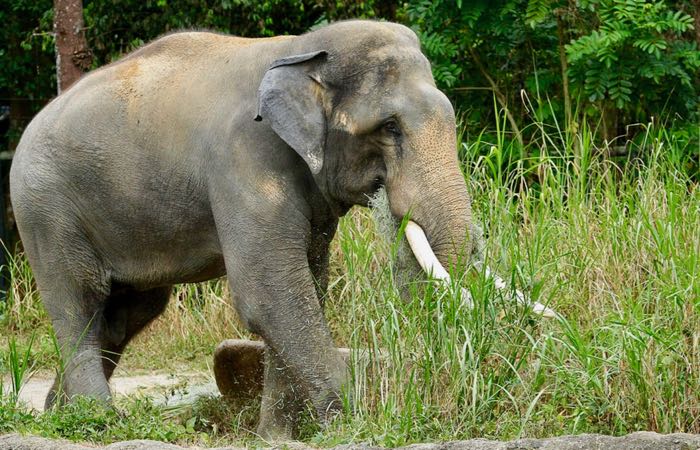
Get up close and personal to wild animals at night. Next door to Singapore Zoo and well worth the trip to Singapore’s northern reaches, this wildlife park is only open in the evenings (7:30pm-midnight). It’s a wonderfully eerie experience – wandering the footpaths and bridges of the fragrant nighttime jungle and seeing the 120 species of nocturnal creatures close up: tigers, fishing cats, and alligators, to name a few. Electric trams run the perimeter, stopping in several places; it’s worth taking one for the guided tour that’s an excellent introduction to the park. Along the way you may spot some of the antelopes that roam free outside the other animal enclosures. The 20-minute Creatures of the Night show, held 3-4 times nightly, is a big hit with kids, and one of the highlights of the Night Safari is a stroll through the fruit bat enclosure, where you may find yourself face to face with a giant fruitbat, hanging upside down inches from your face and tucking into a chunk of fruit. No flash photography is allowed in the park.
Nearest transport: Ang Mo Kio MRT, then bus #138. -
Day out at Singapore Zoo
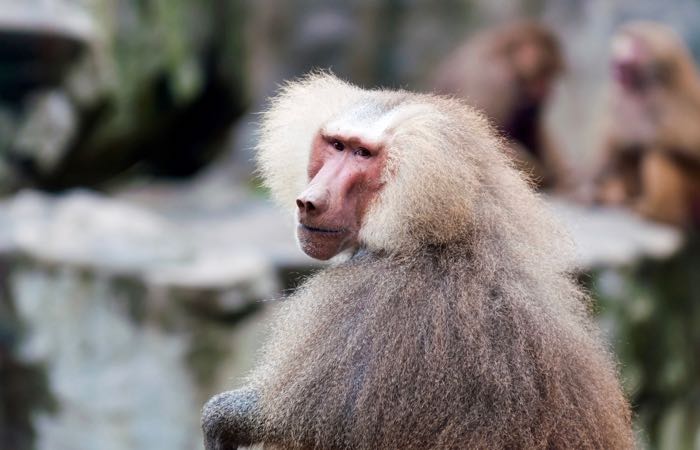
One of the world’s best zoos. Spread across 28 lush hectares on a peninsula in the Upper Seletar Reservoir, the Singapore Zoo is beautifully designed, with globe-spanning wildlife roaming large, natural habitat-like enclosures. The Great Rift Valley (complete with a cliff-cascading waterfall) is home to Nubian ibexes, baboons and mongooses, while in the Fragile Forest biodome you can climb up to the forest canopy to check out two-toed sloths and to spot lemurs and flying foxes. Denizens of the Frozen Tundra include polar bears, wolverines and raccoons, while Primate Kingdom is where you’ll spot all sorts of monkeys – from the colobus to the crested macaque – and get a good look at the zoo’s orangutans during the daily 11am and 3:30pm feeding sessions. Head for Wild Africa and Cat Country to see lions, leopards, cheetahs, giraffes and zebras and to the Forest Lodge to spot the rare white tiger. The Rainforest Kidzworld is great for younger kids, with pony rides and a wet play zone with waterslides. A tram looping through the park gives your tired feet a break.
Nearest transport: Ang Mo Kio metro, then bus #138. -
Wander around Gardens by the Bay
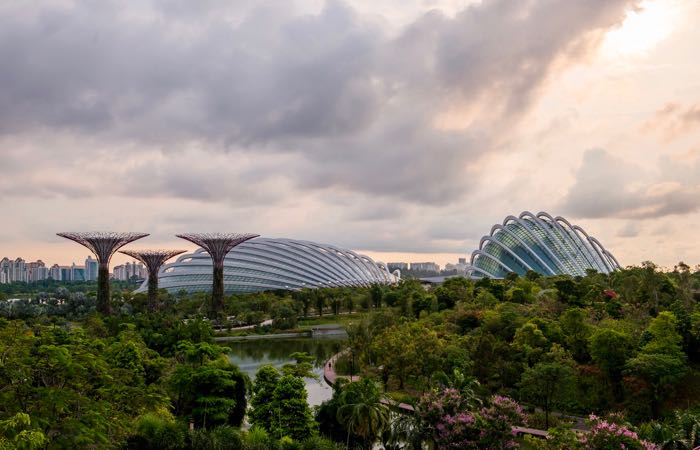
Futuristic botanical gardens with Supertrees and biodomes. Across a pedestrian walkway from the Marina is one of Singapore’s most remarkable green spaces, created on 101 hectares of reclaimed land. Enormous biodomes rise out of the greenery, housing over 800 species of plants from different climate zones. There’s giant cacti in the Desert Dome, a waterfall cascades from a 35m mountain in the Cloud Forest Dome, while the Flower Dome recreates a Mediterranean climate, complete with an ancient olive grove. Dotted around the Gardens are different whimsical sculptures, including Planet by Mark Quinn – a giant sleeping baby that seems to hover in mid-air. Rising above the gardens are 18 Supertrees that look like something out of Avatar, particularly when they’re lit up as part of the Garden Rhapsody sound-and-light spectacular every night (7:45-8:45pm). You can take the OCBC Skyway walk, 22m above the Gardens, that connects six of the Supertrees.
Nearest transport: Bayfront MRT. -
Singapore Botanic Gardens
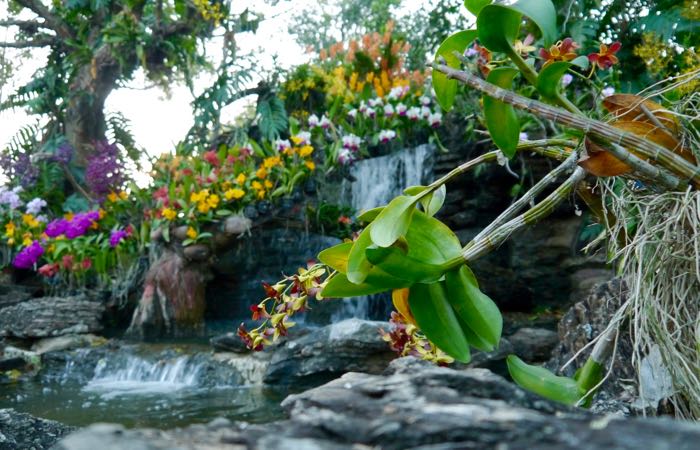
One of the Singapore’s largest green spaces, complete with the world’s most extensive orchid garden. West of Orchard Road, gleaming malls give way to the lush vegetation, well-tended lawns, themed gardens and tranquil lakes that make up the vast Botanic Gardens. A boardwalk runs through a dense patch of ancient rainforest that predates the Gardens; it’s home to 314 species of plants, half of them rare. Of the three lakes, Swan Lake is the prettiest; it’s named after the mute swans imported from Amsterdam. One of the biggest highlights of the Gardens, and a magnet for flower lovers, is the National Orchid Garden. Tropical orchids have been bred here since 1928, and of the 1,000 species and 2,000 hybrids you can see around 600 or so, including ones named after various heads of state as well as politicians: spot the ones named after Princess Diana and Margaret Thatcher. Also worth checking out is the Ginger Garden next door to the orchids, with its 250 members of the ginger family, and two excellent restaurants. The free themed tours of the Botanical Gardens, held on Saturdays, are very worthwhile, and occasional opera performances take place by Symphony Lake.
Nearest transport: Botanic Gardens MRT. -
Shop on Orchard Road
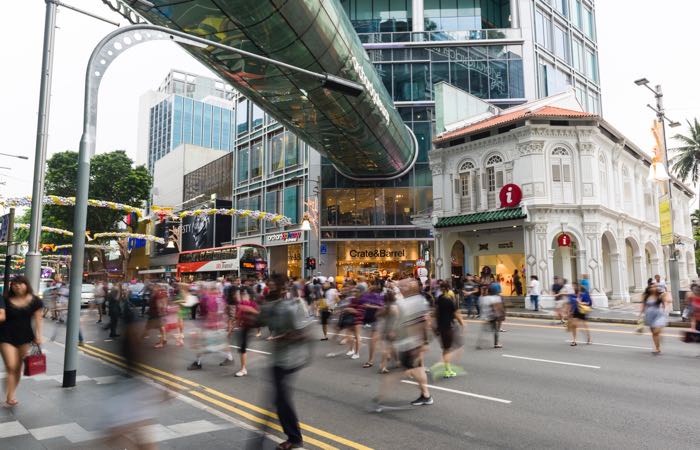
Singapore’s main shopping street, particularly notable for its fashion stores. Its name is a bit of a misnomer, since there isn’t an orchard in sight; instead, you are faced with gleaming malls, departments stores, and designer shops. You can spend days shopping here, sustained by the food from the malls’ excellent food courts. ION Orchard focuses on high street fashion on its lower floors; for haute couture, head upstairs. 313@Somerset stocks reasonably priced high street brands such as Uniqlo and Muji; it’s popular with younger shoppers. Ngee Ann City houses international luxury brands and the superb Takashimaya Food Village – a food court that’s part of the eponymous Japanese department store. Paragon is where fashionistas shop for their Jimmy Choo shoes, threads by Burberry and Hermes, and stylish wear by Singapore’s own Raoul label. If you’re after Asian art, ornaments, and carvings, the retro Tanglin Shopping Centre is an essential stop.
Nearest transport: Dhoby Gaut, Somerset or Orchard MRT. -
Day out at Universal Studios
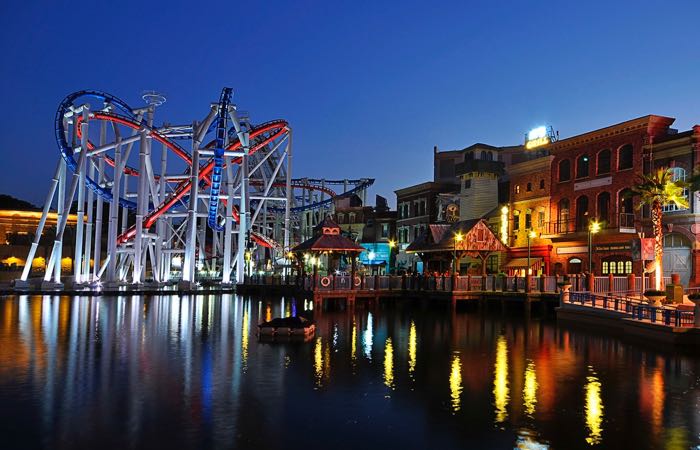
The Singapore branch of the super-popular Hollywood movie theme park. Divided into seven ‘worlds’, this theme park is the star attraction of Resorts World on Sentosa Island, at Singapore’s south end. Very popular with families, it has a mix of attractions suitable for younger kids, such as Puss In Boots’ Giant Journey in Far Far Away, Dino-Soarin’ in The Lost World and the all-singing, all-dancing Sesame Street Show in Hollywood. Thrill seekers should make a beeline for Sci-Fi City for a ride on Battlestar Galactica – the world’s tallest duelling rollercoaster, where you choose between riding the suspended CYLON or the seated HUMAN as they twist, spin and roll. Also in Sci-Fi City, Transformers the Ride takes you on a 3D thrill ride into an urban otherworld, where Transformers do battle and take part in high-speed chases. In Ancient Egypt, don’t miss the Revenge of the Mummy rollercoaster that leads you into fiery encounters with the undead and propels you through darkness. Another highlight is the Lost World’s Waterworld show, based on the Kevin Costner movie; expect plenty of explosions, daring stunts and a thorough soaking if you sit in the front. Tips: purchase the Sentosa FUN Pass if planning to visit other Sentosa Island attractions, and get to the rollercoasters as soon as the park opens to beat the queues.
Nearest transport: Waterfront monorail from HarbourFront.
photo credit -
S.E.A. Aquarium
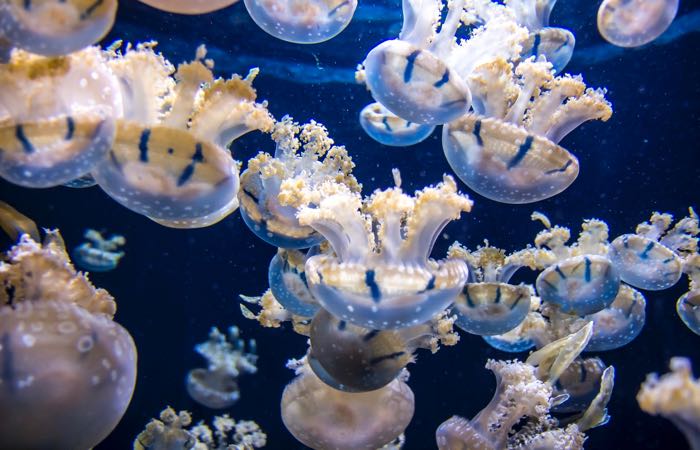
The world’s largest aquarium, with 49 marine habitats and over 100,000 sea creatures. Part of the Sentosa Island attractions, this state-of-the-art aquarium is a terrific journey through the world’s diverse marine habitats. Enter through the shark tunnel, with hammerheads, silvertip and sandbar sharks swimming above your head. Find Nemo and watch writhing eels in the Bay of Bengal, marvel at the colourful reef fish of the Caribbean Sea, check out the fire shrimp and yellow boxfish of the Red Sea, spot the lobsters and the lionfish of the South China Sea, and crawl into a ‘cave’ for an up-close peek at moray eels. Learn about the watery ecosystems of Lake Malawi, kelp forests, and coastal mangroves. One of the most beautiful and unearthly exhibits is Ocean Journey, with eerily-lit jellyfish, monstrous spider crabs, and an enormous deep sea octopus. The vast, 36m-long, 8.3m-high Open Ocean tank is an absolute show-stopper; it brings you face to face with stingrays, sharks, barracuda and other huge open water fish. Daily feedings and the Discovery Touch Pool are fun for kids. Don’t miss the second underwater tunnel, with fish darting in and out of the shipwreck, and learn about Asia’s Maritime Heritage at the on-site Maritime Experiential Museum.
Nearest transport: Waterfront monorail from HarbourFront. -
Ride the Singapore Flyer
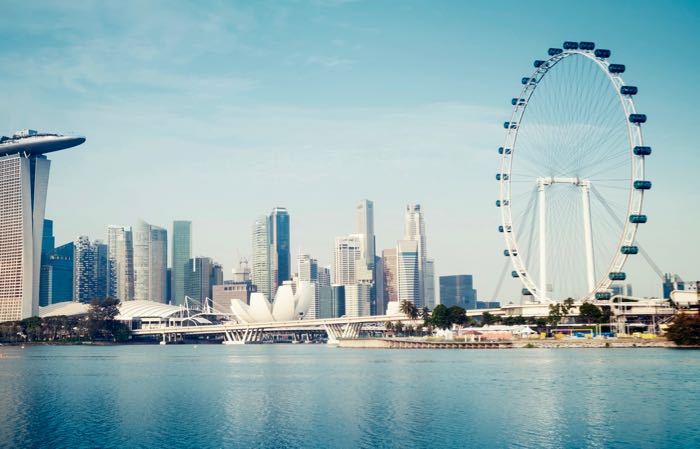
One of the world’s largest observation wheels. Overlooking the water near Marina Bay, this 165m-tall ferris wheel is a quintessential part of Singapore’s skyline, and particularly impressive when lit up in the evenings. The second-largest observation wheel in the world after the High Roller in Las Vegas, the Singapore Flyer whisks you high above the city, offering 30 minutes of terrific views of the Marina Bay, the skyscrapers of CBD, the river, the historic buildings of the Colonial District, and ships on the South China Sea. Discounts are available if you purchase your ticket online.
Nearest transport: Promenade MRT. -
Walk around Marina Bay
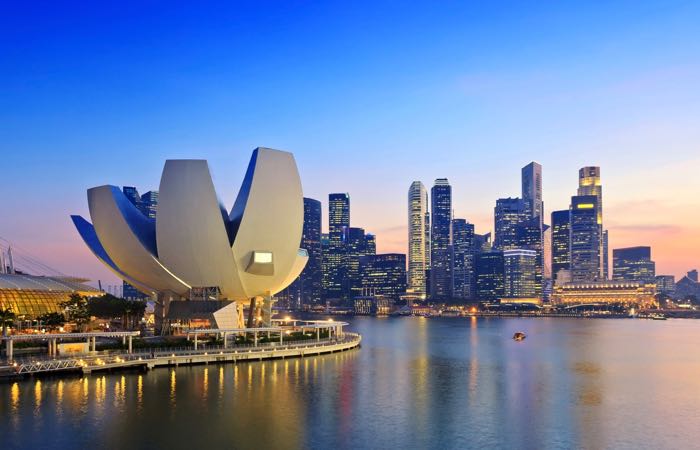
A popular waterfront sightseeing walk. Start your walk from the iconic Marina Bay Sands hotel, shopping, and restaurant complex, and walk north alongside the Marina. You’ll cross the Helix Bridge, from which you get excellent views of the Singapore skyline. Heading west along the Marina Promenade, you’ll pass Gluttons’ Corner – one of the Singapore’s best open-air food courts, as well as the gleaming Esplanade – Theatres on the Bay – a performing arts center that looks like giant metal golf balls. Head south along the Esplanade Bridge to the famous Merlion statue (half-fish, half-lion) that spews water into the bay and is lit up twice-nightly as part of the Marina Bay Sands’ sound-and-light show. Cut west to the south bank of the Singapore River and wander past the 19th century Cavenagh Bridge and sculptures by the likes of Salvador Dalí and Botero. Continue along Boat Quay, where bars and restaurants line the river. Cross the Elgin Bridge to the north side of the river and double back along the waterfront, past the Asian Civilisations Museum, the Victoria Theatre and the statue of Sir Stamford Raffles, the founder of Singapore. Head north past the futuristic, Norman Foster-designed New Supreme Court and the beautiful St Andrews Cathedral before ending the walk with a Singapore Sling at the elegant colonial Raffles Hotel.
Nearest transport: Bayfront MRT. -
Take a walk through Chinatown
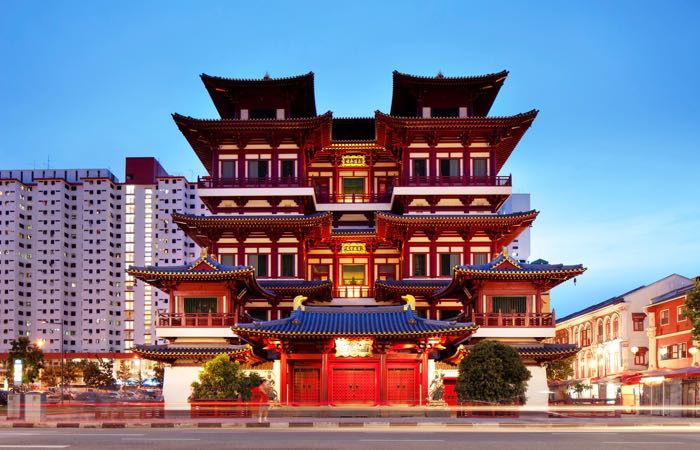
A stroll through the heart of Singapore’s (mostly) Chinese heritage. From the Chinatown metro stop, walk along Pagoda St, with its tacky souvenir shops, massage parlours and restaurants, and stop halfway along at the Chinatown Heritage Centre. Inside, you’ll find exhibits on Chinatown’s colorful past – from evocative photos to replicated living quarters of opium addicts. Then continue to the end of the street to the Sri Mariamman Temple – Singapore’s oldest Hindu temple with a riot of technicolour sculptures. Take kitschy Trengganu St south to the Chinatown Complex, with its popular hawker stalls upstairs. From there, Keong Saik Road curves south past the impressive Sri Layan Sithi Vinayagar Hindu Temple. Take a left into Kreta Ayer Rd, and another left into Neil Rd; where it meets South Bridge Rd is the Jinriksha Station which was once the depot for hand-pulled rickshaws. A couple of blocks north looms the five-storey Buddha Tooth Relic Temple, with (allegedly) Buddha’s left canine residing in a solid gold stupa. Take Ann Siang Rd east past the Art Deco buildings that once housed Chinese guilds and clubs, and check out the dragon ‘wishing well’ at the Siang Cho Keong Temple on Amoy St. Take Telok Ayer St north past the 19th century Al-Abrar Mosque and the gorgeous Thian Hock Keng Temple, finishing the walk at the ornate 1822 Ying Fo Fui Kun clan building used by the Chinese Hakka community.
Nearest transport: Chinatown MRT. -
Take a River Safari
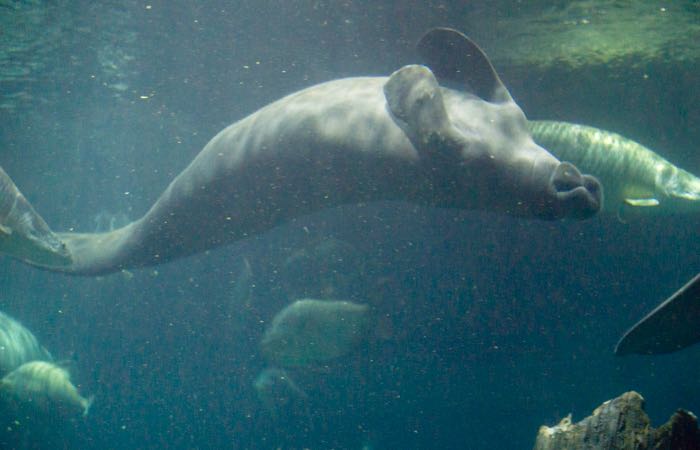
Next door to Singapore Zoo, the River Safari recreates the habitats of seven of the world’s rivers. Spot the alligator gar and the strange-looking Mississippi paddlefish in the Mississippi River aquarium, the African dwarf crocodile in the Nile, the Indian gharial in the Ganges, giant catfish in the Mekong, and the Yantze alligator in the Mekong. There’s a splash-tastic Amazon River Quest boat ride that’s suitable for young kids, with monkeys, giant anteaters, tapir, capybara, and jaguars spotted along the way. Another highlight is the Giant Panda Forest, home to Singapore favourite Kai Kai, as well as rare red pandas. The Amazon Flooded Forest aquariums are superb: you get a good look at electric eels, piranhas, manatees, and the huge aparaima and pacu fish. Book tickets online for discounts; the worthwhile Park Hopper combo ticket is valid for the Night Safari and Jurong Bird Park, as well as Singapore Zoo and River Safari.
Nearest transport: Ang Mo Kio MRT, then bus #138.
photo credit -
Go shopping in Haji Lane
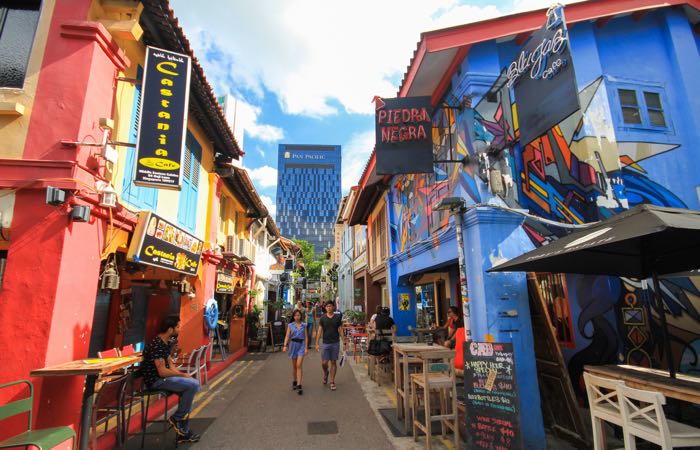
The best street in Singapore for independent designers. In Kampong Glam, Haji Lane – one of the narrowest streets in Singapore – is lined with historic shophouses. Most of them are homey, quirky shops and boutiques showcasing the wares of hip, independent designers – mostly local, but a few international ones as well. Time After Time at no. 82 is a cute little vintage store where you can find a good mix of vintage dresses, hats and accessories; you can also pick up vintage dresses in Craft Assembly at no. 61. Spoilmarket at no. 74 carries colorful women’s apparel, quirky bags, clocks, and other knick-knacks. Finally, sharp tailoring for women is the focus at Soon Lee, no. 73, with beautiful pieces from local designers, as well as designers from Hong Kong and Korea.
Nearest transport: Bugis MRT.
photo credit -
Explore Fort Canning Park
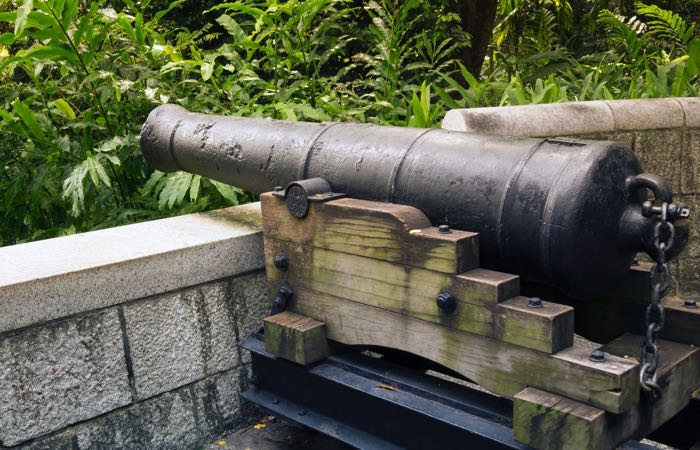
A hilly park topped with a historical museum. A green, cool retreat from Singapore’s hustle and bustle, Fort Canning Park is an appealing green space in the middle of the city. Its defining feature is Fort Canning Hill; when Sir Stamford Raffles claimed Singapore for Great Britain in 1823, the hill, then known as Bukit Larangan (Forbidden Hill) was avoided by locals out of reverence for the shrine of ancient Singapura’s last Malay ruler, Sultan Iskandar Shah. Today the hill features an atmospheric museum, The Battlebox, that tells the story of what’s considered to be “the worst disaster and largest capitulation in British military history.” The surrender of Singapore to the Japanese on February 15, 1942, marked the beginning of the end for the British Empire. Battlebox was a British underground command centre during WWII and its creepy subterranean rooms use lifesize models to re-enact scenes from the war. Access is by guided tour only; professional guides talk you through Fort Canning Hill’s 700-year history. Concerts and other outdoor events are held in the park throughout the year, including Ballet Under the Stars in July and Films at the Fort in August.
Nearest transport: Dhoby Gaut MRT. -
Visit the National Museum of Singapore
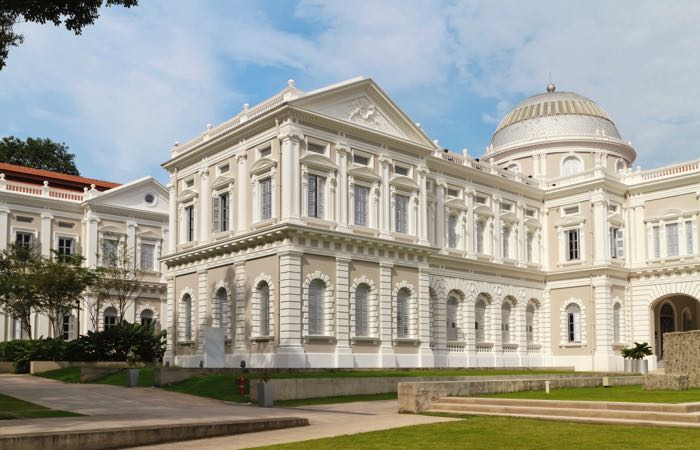
Singapore’s fantastic history museum – if you only visit one museum in Singapore, make it this one – the beautifully designed themed galleries bring Singapore’s rich history to life. Multimedia elements let historical characters speak for themselves, from colonial era high society ladies to common street vendors. Walk through the Living Galleries that explore Singapore culture through the themes of Fashion, Food, Photography and Film. The History Gallery takes you from Singapore’s early beginnings, when it was ruled by Malay sultans, through its years of British colonial rule to the modern metropolis of the present day. En route you’ll peek into a recreated opium den, and hear the heartbreaking stories of Singaporeans under Japanese occupation during WWII. We Built a Nation looks at the first ten crucial years of Singapore’s independence from Britain (1965-75) that laid the foundations for today’s prospering city-state. History aside, there is also the Goh Seng Choo gallery that features 19th century botanical watercolours, as well as temporary art exhibitions. Contemporary art installations greet visitors as they come through the main entrance, and the museum building itself is architecturally striking: the 19th century Neo-Palladian and Renaissance building was revamped a decade ago to include a dome-topped stained glass rotunda.
Nearest transport: Dhoby Gaut MRT. -
Visit the Peranakan Museum
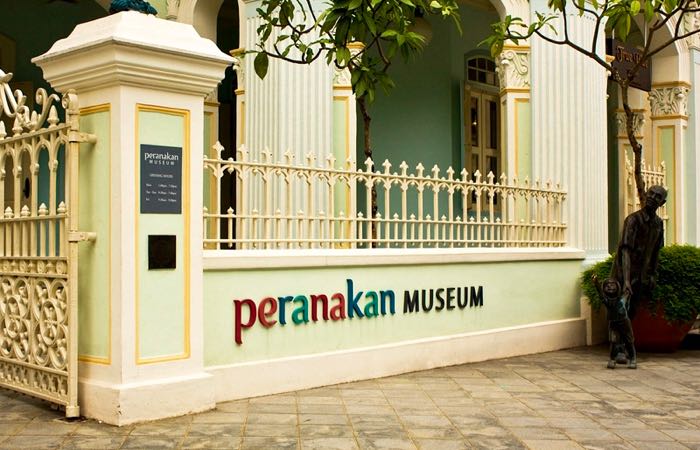
A museum showcasing a unique hybrid Southeast Asian culture. Peranakan or Nyonya refers to people of mixed origins, and in Singapore, most Peranakan people tend to be Straits Chinese. The museum’s colorful introductory gallery features quotes from Singapore’s present-day Peranakan population, asking “What makes you feel Peranakan?” with answers focusing on anything from favorite dishes to traditional weddings. The themed exhibitions on the three floors of this heritage building take you through Peranakan traditions, from feasts and weddings to religion and mourning. In the Wedding gallery, see a typical wedding procession, peek inside the wedding chamber and marvel over the many examples of fine Peranakan beadwork used to decorate garments. In Language and Fashion, see how the changing notions of femininity through the ages have altered the sarong kebaya, a Peranakan woman’s garment of choice, and learn about the importance of storytelling as a way of preserving Nyonya culture. Food and Feasting explores the importance of food, from dining customs to the actual fusion dishes that combine Chinese, Malay, Indonesian, European and other influences. Religion focuses on ancestor worship, the importance of death rituals and elements of Daoism and Buddhism, while Public Life introduces many prominent Peranakans who have played an important role in Singapore’s political and social affairs.
Nearest transport: City Hall MRT.
photo credit -
Explore the Marina Bay Sands
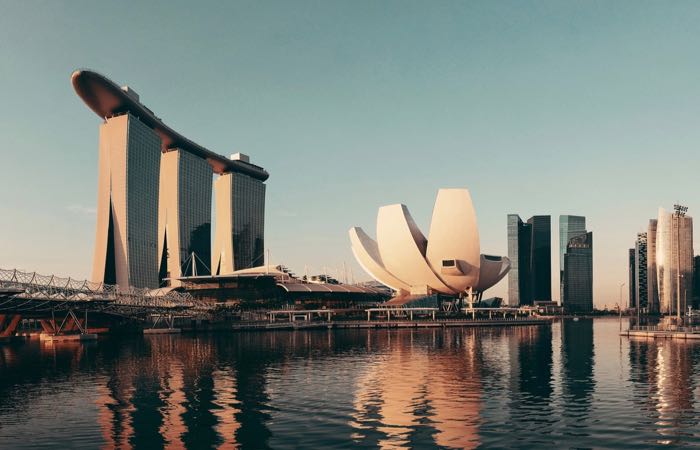
Dominating Singapore’s skyline ever since it was built, the eye-catching Marina Bay Sands, designed by Israeli-Canadian architect Moshe Safdie, is a massive hotel complex and one of the city’s most popular attractions and a destination in itself. Visitors can shop at the designer stores of the ritzy mall beneath the hotel, dine in the mall’s many restaurants (several of them Michelin-starred), catch a popular musical at the MasterCard Theatre and check out cutting-edge temporary exhibitions (from Annie Leibovitz photography to the demise of The Titanic) at the waterfront ArtScience Museum that looks like a giant lotus flower. One of the most popular attractions (though not if you get vertigo!) involves zooming up to the cantilevered SkyPark at the top of the hotel –the dramatic overhang high above Marina Bay. Beside the infinity pool (for overnight guests only), the hotel offers an excellent restaurant and bar. The Observation Deck gives you incredible views of the city, particularly in the evenings, when Singapore’s skyline lights up. Evenings are also an excellent time to be out by the water’s edge, where the hotel stages Spectra, a free nightly 15-minute sound-and-light extravaganza that transforms the Bay into a spectacle of dancing, color-changing fountains, with the water acting as a screen for projected images.
Nearest transport: Bayfront MRT. -
Have a Singapore Sling at Raffles Hotel
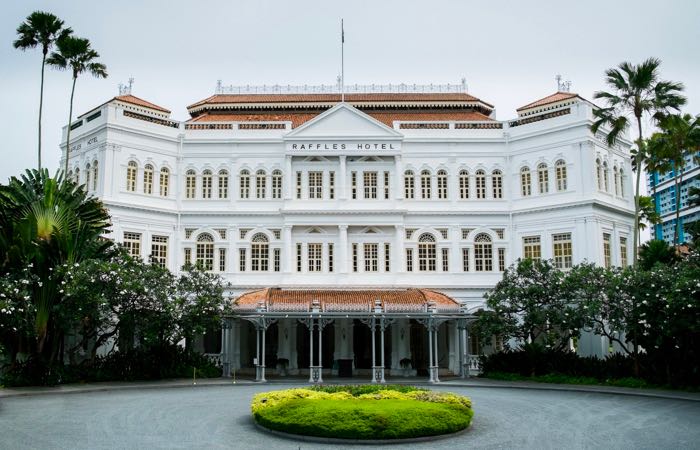
Singapore’s signature cocktail at Singapore’s most famous heritage hotel. Coming to Raffles Hotel for a Singapore Sling is a bit of a cliché, but a delightful one! Few visitors to Singapore can resist visiting the city’s most famous heritage hotel, with its smartly-dressed Sikh doormen, tropical gardens and boutiques, illustrious history, and of course, the legendary Long Bar at Raffles. Ever since it opened as a luxury hotel in 1899, Raffles has been a byword for colonial luxury and its guest list has been a Who’s Who list of royalty, politicians, famous writers, and playwrights. Raffles has appeared in novels by Somerset Maugham and Joseph Conrad, and Noel Coward and Hemingway used to come and drink in the Raffles Bar. Today’s Long Bar is not in the same part of the hotel as the original, but it retains an old-world charm: ask to hear the story of the tiger that escaped from a nearby traveling circus in 1902, managing to get inside the luxury hotel and meeting a fateful end beneath the Raffles’ billiard room. There are other drinks on offer, but many visitors want to try the famous Singapore Sling – a pink mix of Cointreau, pineapple juice, lime juice, cherry liquor and grenadine that was first mixed here by bartender Ngiam Tong Boon in 1915. Long Bar is pretty much the only part of Raffles Hotel where you don’t have to dress up to the nines, but guests are expected to dress smartly.
Nearest Transport: City Hall MRT. -
Explore Geylang
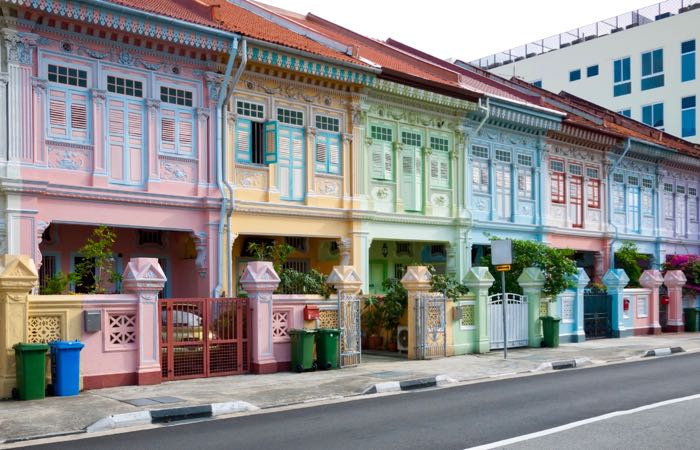
Historic shophouses in Singapore’s red light district. Geylang’s streets and buildings bear little resemblance to the gleaming, futuristic metropolis just a few kilometers west. Seedy by night, during the day the streets make for fascinating walking, as there’s a very distinctive vibe, with much of the architecture dating back to the turn of the 20th century. When Singapore expanded westward, it drew industry to the area, and with it the immigrant populations that arrived to work in the factories. Temples, mosques and churches sprung up in Geylang’s narrow streets to cater to their spiritual needs, and to date Geylang remains one of Singapore’s spiritual hubs. The lorongs (narrow lanes) branching off from Geylang Road are particularly interesting to wander. Lorong 24A has two rows of particularly beautiful and well-preserved Late-style two-story shophouses – narrow houses built in a row, with a sheltered corridor at the front and internal courtyards, these are particularly representative of Singapore’s mixed heritage. Their design incorporates Chinese porcelain-chip friezes, French windows, Malay timber fretwork and Portuguese shutters. More austere late 1930s Art Deco shophouses sit between Lorong 30 and Lorong 28, while other colorful Late-style houses can be spotted along Lorong 25. Have a peek at the private Gek Hong Temple at no. 14 along Lorong 26: this bungalow on stilts built in Malay kampong style harks back to the early 19th century time that predates Singapore.
Nearest transport: Aljunied MRT. -
Day out in Jurong Bird Park
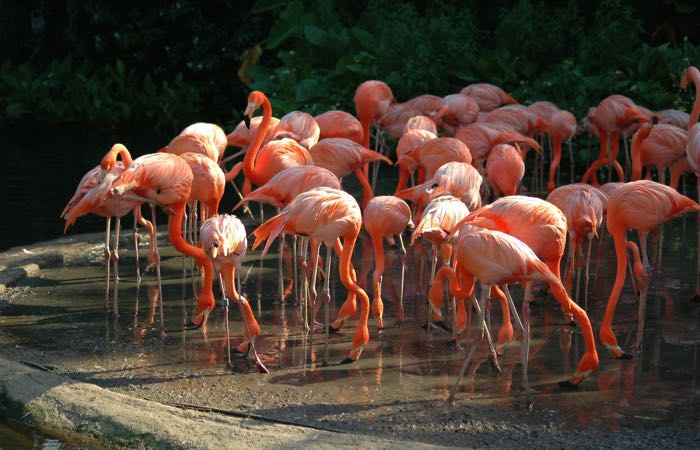
A bird sanctuary that’s home to 400 bird species. Well worth the trip into the western part of Singapore, Jurong Bird Park is very popular with families. The park is divided into zones that mirror the birds’ natural habitats, and visitors can either take stroller-friendly walking paths or ride the tram that encircles the park and stops at three stations along the way. Near the entrance, Penguin Coast is home to several penguin species from Antarctica, and you can watch them frolic and dive; outside, visitors can participate in feeding their African penguins. World of Darkness is the place to see owls and other denizens of the night, while ibises and spoonbills splash about in the Wetlands and hundreds of flamingos strut around Flamingo Lake. Lory Loft is a huge aviary where you can attract these small, colorful birds with cupfuls of nectar, while the Waterfall Aviary, with its 30m waterfall, is a good place to spot shyer birds, such as the turaco and guinea fowl. The park is heavily involved in the breeding and conservation of endangered species and their success stories can be seen in the Toucan and Hornbill Aviary. There are plenty of activities for kids, too, from the wet and wild Birdz of Play playground/waterpark to the daily High Flyers show and the particularly impressive Kings of the Skies show that demonstrates the ancient art of falconry with various birds of prey.
Nearest transport: Boon Lay MRT, then bus #194. -
Eat your way around a Hawker Centre
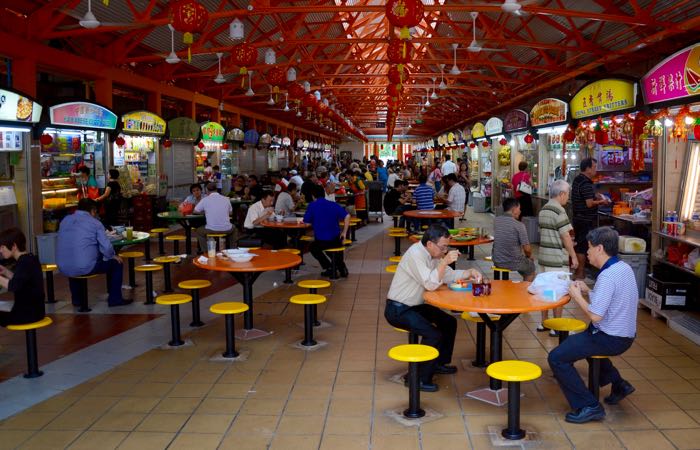
Popular food courts serving Singapore’s best street food. Singaporeans are serious about food, and in an expensive city, eating out at hawker centres – large food courts that bring together street food stalls serving anything from snacks to full meals – is a vibrant and quintessentially Singaporean experience. Hawker centres tend to get packed, so to secure your seat at a canteen-style table, just place a packet of tissues on it. One of the most popular is Lau Pa Sat (24 hours; 18 Raffles Quay, Raffles Place MRT) in the business district, serving dishes from all over the world in a handsome 19th century cast-iron building. In front of Lau Pa Sat the Satay Street stalls come to life in the evenings, with smoky satay skewers on the grill and drink sellers peddling cold beer. Another good place for satay is Satay By The Bay (11am-10pm, Bayfront MRT) in the Gardens By The Bay, with hokkien mee noodles and halal seafood complementing the satay stalls. For a local experience, head out to Old Airport Road Food Centre (8am-11pm, Dakota MRT) where locals chow down on char kway teow (stir-fried rice noodles), noodle soup, seafood dishes and more. Chinatown Complex (11 New Bridge Road, Chinatown MRT) is also a very local scene, with claypot rice, congee (savory rice porridge) and noodle dishes on offer, while nearby, on Smith Street (aka Chinatown Food Street), stalls serve roast duck with rice and noodles to a mix of tourists and locals.
photo credit -
Kampong Glam Heritage Trail
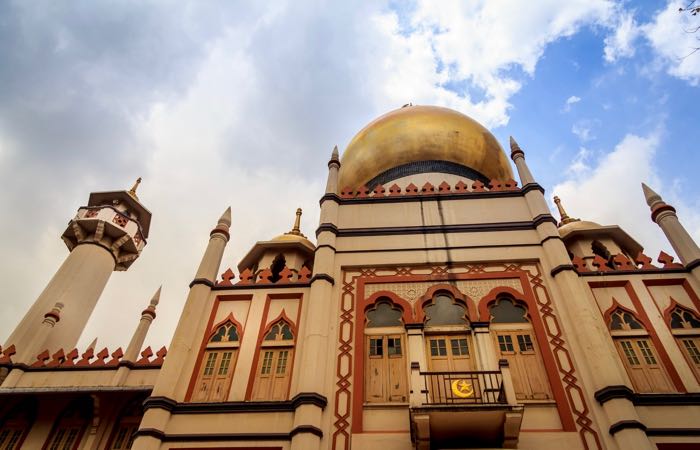
A walk exploring Singapore’s Malay neighbourhood. Like Chinatown and Little India, Kampong Glam is a former fishing village that retains its historic Malay-Arab roots. Start your exploration of the neighborhood at the Malay Heritage Centre inside the Istana Kampong Gelam (Kandahar St.) – the 19th-century residence of Malay royalty. Continue to Gedung Kuning (“Yellow Mansion”) at 73 Sultan Gate. This traditional Malay house with some European influences once belonged to Javanese merchant Haji Yussof. Nearby is Pondok Java, an example of a communal lodging house that used to house new arrivals from Java and served as a Javanese community centre. You’ll pass a number of traditional shophouses before reaching two early 20th-century schools in an Art Deco building (30-32 Aliwal St), started by the Hokkien Chinese community. Next up is the 1912 Madrasah Alsagoff Al Arabiah (Alsagoff Arab School) at 111 Jalan Sultan, the oldest surviving Muslim school in Singapore. Nearby, North Bridge Road is lined with restaurants where you can sample Indonesian dishes, such as nasi padang (steamed rice) with rendang (meat simmered in spices and coconut gravy). North Bridge Road intersects with Arab Street, one of Singapore’s oldest; it has been attracting merchants and entrepreneurs since the early 1900s and today it’s lined with textile shops and shops selling frankincense and myrrh. Finish your walk at the grand Masjid Sultan Mosque at 3 Muskat St (open to visitors).
Nearest transport: Bugis MRT. -
Walking tour of Little India
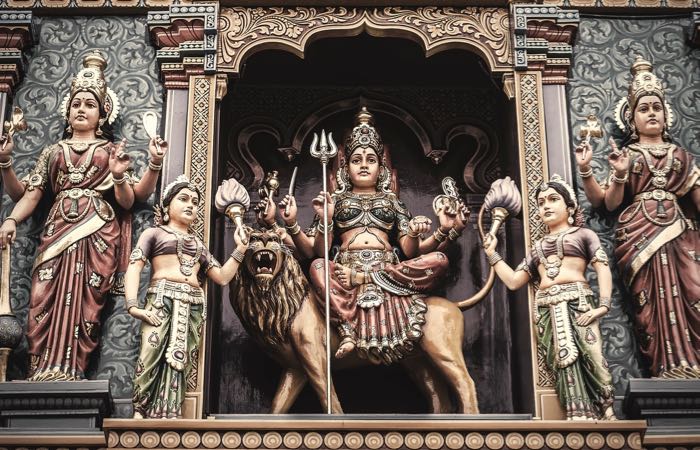
One of Singapore’s most vibrant neighborhoods. With its incense-scented streets, colourful temples and delicious smells wafting from its many eateries, Little India has a very distinctive vibe. Cattle trading took off here in the mid-19th century, quickly becoming a largely Indian trade, with immigrant workers arriving from India and mosques and Hindu temples springing up to meet spiritual demand. The cattle have long been replaced with sari and goldsmith shops, stores selling flower garlands, and Indian restaurants; but the temples are still here. Begin exploring by heading north up Race Course Rd from Farrer Park MRT, have a look at the Buddha image inside the colorful Sakya Muni Buddha Gaya Temple, then check out the eye-catching Taoist Leong San See Temple across the street before heading south along Serangoon Road, Little India’s main thoroughfare. See worshippers come to give thanks to Lord Vishnu at the Sri Srinivasa Perumal Temple, and stop to shop for cheap electronics at the Mustafa Centre on the corner of Syed Alwi Rd. Continue south to the striking Sri Veeramakaliamman Temple – Little India’s main Hindu temple – before detouring east along Dunlop St to admire the row of shophouses and the intricately decorated Abdul Gafoor Mosque. Double back and head west along Kerbau Rd to the kaleidoscopically colourful Tan Teng Niah, Little India’s last surviving Chinese villa. Duck into Buffalo Rd, where vendors hawk fresh produce, before finishing with an authentic Indian meal at the Tekka Centre.
Nearest transport: Farrer Park MRT. -
Hike around Mt Faber Park & the Southern Ridges
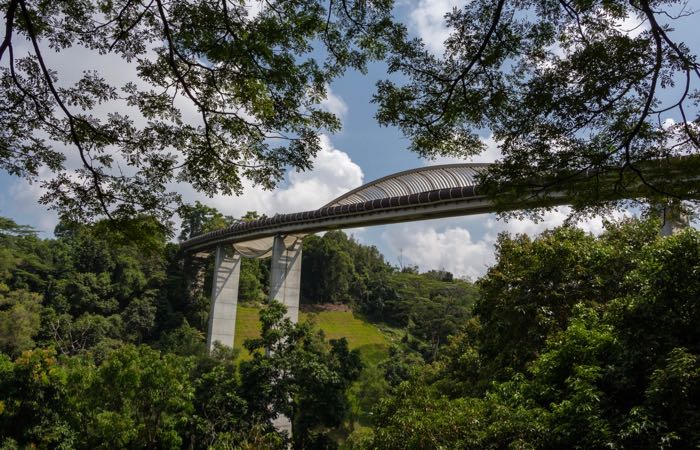
One of Singapore’s oldest parks, Mt Faber is the city’s second highest hill, covered in secondary rainforest. It is also part of the Southern Ridges that comprise several other parks and 9km of peaceful walking trails, ranging from easy to moderately demanding. Take a cable car ride to the summit of Mt Faber from Sentosa Island or HarbourFront – you get wonderful views of southern Singapore and the southern islands en route, as well as from the viewing platform on Faber Peak itself. Next take a scenic walk to Kent Ridge Park, 4km west. First, head down to Henderson Waves, an undulating canopy walkway 36m above the forest floor that connects Mt Faber to Telok Blangah Hill Park. Linger at the Terrace Garden with its fantastic 360-degree views of Singapore. Then you can either take the Elevated Walkway that lets you spot birds and butterflies in the forest canopy, or the more rugged Earth Trail before you reach the Alexandra Arch that takes you to HortPark. Wander through HortPark’s themed gardens before finishing your walk at Kent Ridge Park, where one of the last battles for Singapore was fought in WWII. Reflections, the museum opposite the short Canopy walk, tells the sombre story.
Nearest transport: HarbourFront MRT. -
Take a Singapore River Cruise by night
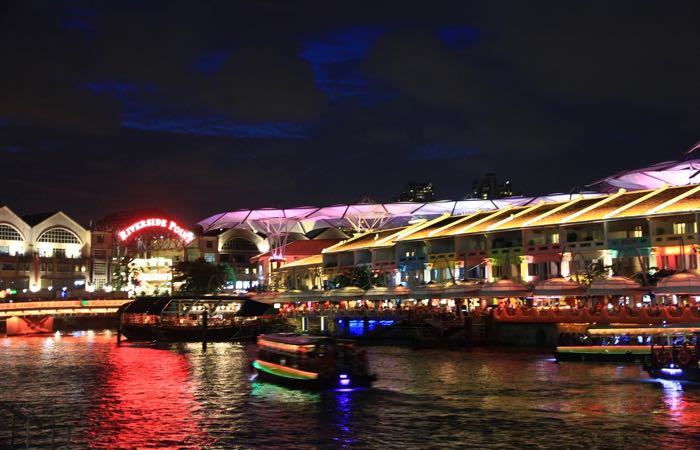
Particularly atmospheric by night, when Singapore’s skyline is beautifully lit up, these 40-minute cruises run every 15-20 minutes between the iconic structures of Marina Bay and the vibrant nightlife of Clarke Quay, with running commentary giving you some entertaining background history. You can hop on and off at several different locations, but your best bet is to catch the boat at the Promenade Jetty, in front of the Singapore Flyer – that way you catch a glimpse of the lit-up Gardens by the Bay. The boat then loops around Marina Bay, taking in the Merlion, Marina Bay Sands hotel, and the Esplanade before cruising past the grand Palladian edifice of Fullerton Bay Hotel and the impressive skyscrapers of the CBD (Central Business District) that make up most of Singapore’s skyline. The three tallest buildings to watch out for are: UOB Plaza One, Republic Plaza and One Raffles Place. Against the backdrop of the CBD are the touristy bars and restaurants of Boat Quay; carry on to Clarke Quay for more authentic Singaporean nightlife. The slightly more expensive cruises depart at 7:30pm and 9pm to coincide with laser shows on the Marina Bay and include a Singapore sling or juice per passenger.
Nearest transport: Clarke Quay or Bayfront MRT. -
Visit the Asian Civilisations Museum
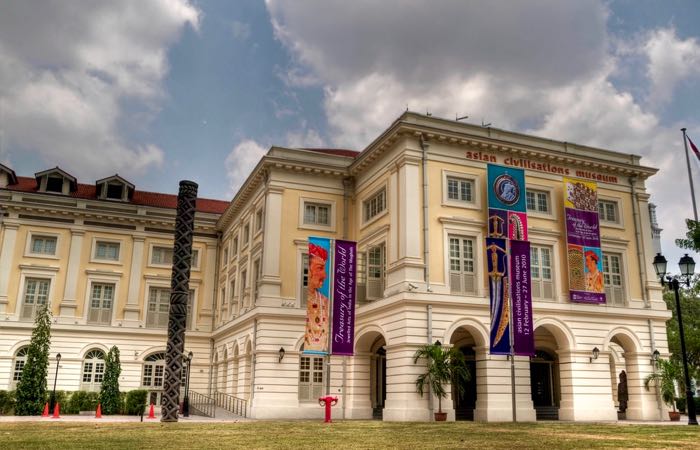
Singapore’s superb collection of pan-Asian treasures. Inside a handsome 19th century building overlooking Singapore River, the expertly curated galleries of this world-class museum explore the culture and history of the Asian subcontinent, China, South Asia and the Islamic World. The Tang Shipwreck gallery focuses on the remarkable cargo of a sunken 9th century Chinese ship bound for Iran, and the revelation that Singapore was an important part of a trade network 1,100 years ago. The Trade galleries trace ancient trade routes in Asia, showcasing carved ivory, exotic woodworks, fine gold and silver objects, and ceramics and textiles. The Ancient Religions gallery follows the spread of Buddhism, Hinduism, and Jainism through Asia, while the Southeast Asia galleries (due to reopen in early 2017), will once again cover diverse cultures spanning 2500 years – from the Dayaks of Borneo and the Hmong of Northern Thailand to the Javanese Kingdoms and the Malay world. Silk panels and lacquerwork from China and priceless bronzes from India are among the museum’s other treasures, while the Kewk Hong Png wing displays cutting-edge contemporary art.
Nearest transport: Raffles Place MRT.
photo credit -
Enjoy Clarke Quay Nightlife
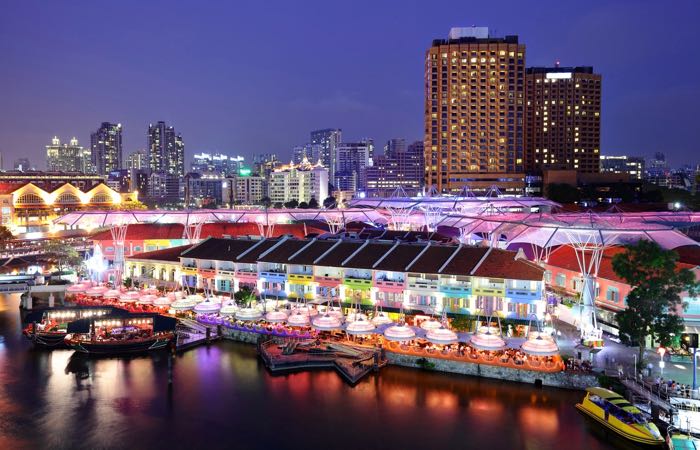
With bars, clubs, and restaurants lining both banks of the Singapore River, Clarke Quay really comes into its own in the evenings, when professionals working at the nearby Central Business District head there to join the tourists and unwind. The stripped-down and grungy Crazy Elephant is a good spot to catch some blues and classic rock; things kick off around 10pm, and it’s also one of the cheapest places on the Quay for beer. For a bit of adrenaline, get fired out of the G-Max Reverse Bungy Catapult or swing above the river on the GX5 Swing. If you want to carry on partying into the wee hours, Attica is a large, popular club with several different zones: choose from hip-hop, house and electronica; international DJs play the occasional set here, as well. If you’re serious about your dance music, then your night won’t be complete without visiting Zouk, Singapore’s first Ibiza-style superclub that attracts the likes of the Chemical Brothers and David Guetta.
Nearest transport: Clarke Quay MRT. -
Visit National Gallery Singapore
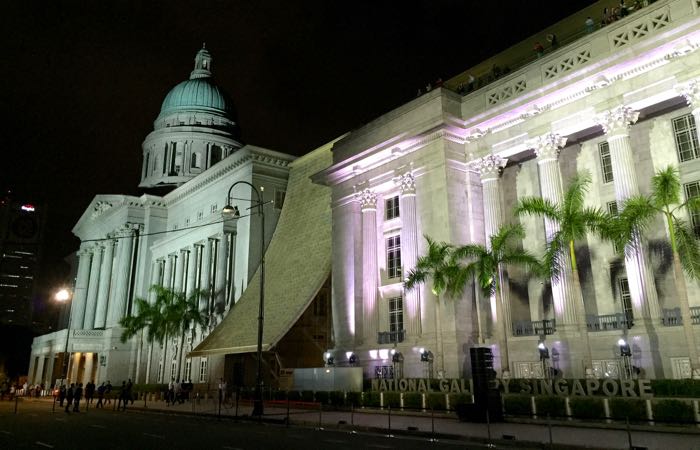
The largest collection of modern art in Singapore and Southeast Asia. In 2015, this new gallery opened in the beautifully restored former Supreme Court. Exhibitions reflect Singapore’s unique cultural heritage and geographical location, and showcase the best of the city’s art from the 19th century to the present day, as well as art from all over Southeast Asia. The permanent DBS Singapore Gallery explores the changing relationship between art, artist, and community, with chronologically-arranged Singaporean art reflecting different artistic trends – from the European-style landscapes of early colonial Singapore to the abstract art of the 21st century. Free tours run at 2pm daily on a first come, first served basis. The other permanent gallery, Between Declarations and Dreams, traces the major artistic movements across Southeast Asia and their influences: local traditions, colonialism, artistic trends from the West and major political changes; the anti-establishment art of the 1970s is particularly interesting. Daily 3:30pm tours add context. Past temporary exhibitions have included sculpture by Vietnamese-born Danish artist Ng Teng Fong, and landscape paintings by Chinese artist Wu Guanzhong. Apart from its stellar art collection, the National Gallery has a vibrant dining scene that includes Odette (contemporary French), Aura (classic Italian), Yan (sophisticated Catonese), Smoke and Mirrors (roof bar with signature cocktails and cakes), and National Kitchen by Violet Oon (Peranakan cuisine).
Nearest transport: City Hall MRT.
photo credit
About Santorini Dave